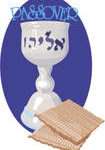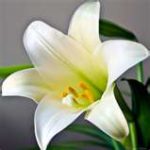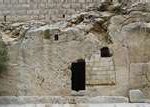
From a talk given by Marlena Tany Muchnick at the Renton Stake Seminary class in April 2012.
In Exodus 12:14 we read that God commands Jews to observe Passover for seven days, stating: “This is a day you are to commemorate; for the generations to come you shall celebrate it… for seven days you are to eat bread made without yeast.” An extra day was added to the observance of Passover following the exile from ancient Israel in A.D. 70. This exile occurred after the destruction of the Second Temple in Jerusalem when a large number of Jews began living in countries all over the world. That event began the dispersion of the Jews, called the Diaspora.
The Passover Seder is a Jewish ritual feast that marks the beginning of the Jewish holiday of Passover, or Pesach, meaning to pass over or pass through, to be spared. It is conducted on the evenings of the 14th day of the month of Nisan in the Hebrew lunar calendar, and on the 15th by traditionally observant Jews living outside Israel. This corresponds to late March or April in the Gregorian calendar, the one most of the world uses today. It is a holiday full of ritual symbols that retell the Exodus story. Many of these symbols are displayed on the Seder plate, which is the centerpiece of the Seder table.
The word Seder means order or arrangement. A Seder is a service held at home that concludes with a dinner. It is always observed on the first night of Passover, and in some homes on the second night as well. It is an event that is integral to Jewish faith and identity. The Passover feast centers on the paschal lamb, which was a sacrificial lamb, a male without blemish and with no broken bone, even after death. Likewise, Jesus was the “Passover,” the “Lamb of God”, a male without blemish and with no broken bone, even after death. He was the Firstborn of God in the premortal existence, sanctified in the flesh as were the firstborn of Israel, and slain even as were the firstborn of Egypt.
The leader of a seder must be a Jewish man. Anciently, these men knew of their Hebraic tribal designation. In this church, men holding the Aaronic priesthood also know of their Hebraic roots and may sit as head of a Seder meal in lieu of those who can claim a particularly Jewish heritage. Since the Israelites escaped Egypt, we can reason the latter-day Saints’ ancestors were included in that group. The oldest son sits to the right of the father, the youngest near his mother at the foot of the table. Grandparents sit between the daughters who usually sit to the left of the father leader.
As a Jewish convert to this church I learned that the Passover supper is a prophecy of much, much more than a celebration of the freedom of the Israelites to overthrow tyranny and to form their own nation. There were numerous incidents of history that coincided with the Pesach observance. In April 1820, Joseph Smith received a visitation from God the Father and His Son. This occurred during the week of Passover that year, as did the organization of the Church on April 6,1830.
And it was during Passover in 1836, also an Easter Sunday that Moses, Elias and Elijah appeared in succession in the Kirtland Temple and restored priesthood keys. They did not appear at some seder meal, but in a temple of God, restoring the keys of the gathering of Israel, one of the preparations for the Second Coming of Christ and to gather the scattered tribes or families of Israel from all the earth.
Two main themes stand out. The first is honoring the history of a people – from the birth of Judaism to present-day members of the tribes of Israel – with the knowledge that Heavenly Father and those beyond the veil of time observe a world view that presents all things for our good and our deliverance from the world.
Secondly, there is a natural brotherhood between Jews and Mormons – Judah, Ephraim and the other ancient tribal families of Israel. They were that we may be. Let us teach and testify of these events and these truths.
Now think back to the Last Supper of the Savior with his apostles. It was the beginning of the sacrifice that would split heavenly and world history down the middle forever. That meal, that new sacrament of bread and wine taught by Jesus to his quorum of twelve apostles, was the inauguration of his Plan to provide, insure and demonstrate for all of mortality his immortality, his ability and his humble willingness to make the ultimate sacrifice for all people who have and who will ever live – he offers us immortality – and more than that – if we are faithful in our covenants we are promised life eternal with him and with our Heavenly Father and with our families living and dead, throughout time.
Rising from that meal, Jesus the Jewish Mashiach, the Messiah of the world, walked into the Garden of Gethsemane and there took upon himself our sins. He relinquished his will to Heavenly Father that we, his brothers and sisters, might be saved from spiritual death if we would repent of our mistakes, our sins, our imperfections and follow his example throughout our lives. His willingness to die that we might be saved offers us unfailing protection – freedom from the tyranny and oppression of the Adversary who is the master of misery and sorrow, of sin and death.
In Hebrew the name of Jesus is Yeshua and it means – he who saves – he who makes free. In helping the Israelites to become free of the enslavers by instructing them to smear the blood of a lamb on their doorposts when the avenging angels came to destroy, our Savior taught them an urgent, timeless message – to call upon him in our weakness and our travails – regardless of our age or situation and he will help us to carry our burdens and lead us, through his light, out of confusion and error.

Jesus was and is a Master Teacher. He is the unleavened bread of life, the feast of a joyous and peaceful existence. His Plan is the temple of a dedicated heart. He is the sacrificial lamb of this world’s woes, the fruit of the vine of truth through the families of Joseph and Judah, spreading throughout the ages of the earth. He is the fulfillment of divine promise. He warns of the bitter herbs of war, of sin, of lying and treachery. He shed tears not only for our transgressions, but his precious blood. He knows our sorrows and our joys, and I believe that he visits many of us, consoling, loving, lifting us up.
If we look at the Seder meal as a symbol of our lives we can come to understand that what we visually see is but a mere promise of the eternity of choices and patterns that lie before us. The Jews celebrate their Seder and their Passover with a hymn of freedom. They are unaware of the eternal promises and protection that has been made for them and for all of us by the Savior of mankind. You are very young. I hope you will learn to understand the meaning of freedom of choice by sacrificing your personal will to that of our Redeemer, for he will show you how freedom can bring you all out of the slavery of confinement of spirit and into his light. Follow him in all things and thereby achieve far more than you can without his guidance. Freedom and sacrifice are not opposites. Each of us is forever free to choose our path each day.
As you hear the Dayenu song, know that its solitary word translates as: if God had given no more blessings to the Israelites than to lead them from slavery, it would have been enough. Since he did so much more for them, they cannot ever thank Him sufficiently. Let that be a prayer in each of you – sing Dayenu to the Lord for your blessings.
This Sunday we will celebrate Easter in commemoration of that definitive day when the Lord became the Christ. As it succeeds Passover on Friday evening we of this church have the greater understanding of the progression of events that occurred during those seminal and world changing days.
I leave you my testimony that God lives, that Jesus is the Christ, the Mashiach of the world and that following the words of our prophet and other church leaders will bring you a spiritual feast far more filling than anything you can now imagine. In the name of Jesus Christ, amen.

